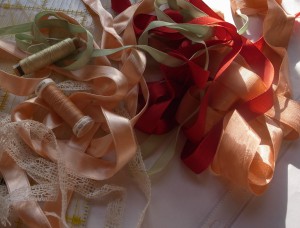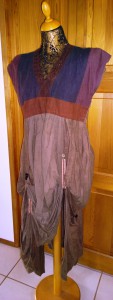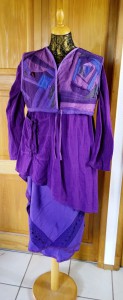At the Moment I´m busy with lingerie-gown no. 2.
It will be different to the first one.
Wait and see!
Actually I should call it my “obstacle-gown”.
From the start, there where some problems. The vintages original (a bridal gown ) included some of the finest, hand-embroidered batiste. Thanks to the californian-treasures, I had a matching piece in the same style and good condition. But it was to broad. To make it fit, I had to to cut it up and remove some of the embroidery on the edge, which I didn´t want to. That ment, I had to find another one. But all I had, was a hand-embroidered piece in a complete different style. It´s pretty too, but matches not half as good, als the other one did. And it was also to broad But I didn´t want to cut it up either.
So I had to add on another row of lace on the neckline, to prevent the gown from slipping down the shoulders.
The neckline of the genuine gown was very high too. I found that not comfortable and decided to give my version more space. I also couldn´t copy the flouncy sideparts, because non of my vintage lace had the right lenght. So I had to adjust the pattern to the existing material.
After that, I found some unexpected little flaws on the net lace, that had to be mend. And than I had to add on some rather rough bobbin-lace, because I hadn´t enough left of the finer ones.
That gives my gown very little resemblance to the original, but I don´t mind. It makes the whole thing more individual.
Certainly, I wear it with some under-gowns in different colors.
At the end I decided to add on a waist-ribbon, because the gown looked much better with a little gathering.
The rose-decoration is handmade from vintage ribbons and the tiny blue flowers handembroidered from old sild thread.
“But”, you would object. “This looks like a night gown!”
That´s right. But the reason ist simple: Till the end of the 1020s, they made no difference in the use of material between girls clothing, womens lingerie, summer dresses and sometimes evening wear. For the whole range, the same lace and fabrics like silk, satin, fine linen or batiste have been wildly mixed. Even the sewing-patterns where nearly the same.
The works of the Callot- und Bouét soeurs are the best examples. They even used the same embellishments for both, gowns and lingerie. So beholders of today can hardly see the difference.

I love the metropolitan-museum´s online-collection. I could spend hours on this website….
One day I stumbled over a 1920s lingerie-gown, made by the callot soeurs.
I wanted to sew myself a similar dress, but then it was impossible- I simply had not enough or the right vintage material to work with. And modern lace and fabric won´t do. They are not comparable in quality nor beauty.
The only solution was to wait and collect. Which I did. For years I stockpiled like a hamster. But some key-pieces still where missing.
Until some weeks ago. Then I got a huge lot of vintage items from California.
The californian treasures included some of the “missing links”, so I could finally start my project: Four dresses, inspired by vintage 1920s lingerie-gowns, made by the boué seours and callot seours.
Of cause, it´s impossible to copy the gowns . The vintage originals are hand-sewn, custom-made luxury-items. They´re made from finest muslin or batiste, heavy embellished with couture-embroidery and priceless lace. I have not the time nor the skills for such embroidery and my stock of fine batiste is very small. And I will use a sewing-machine. It´s also impossible, to use such huge amounts of bulk stock lace, like the couturiers in the 1920s did, Most of the vintage lace pieces on the market today are short. (Or very, very expensive!) And to find the same lace, used for the gowns, is also impractical.
Another problem will be the beautiful patina of the genuine gowns. My material may be from the same era or before, but it comes from several nations and was stocked under completely different conditions. Which means, the patina of my gowns will be mixed.
Seems, I have to make some compromise.
At least, my gowns can only be a poor tribut to the masterpieces from the roaring twenties. Maybe there will be no visible consensus But give up the project? NEVER!
So wait and see, what´s ahead. Gown number one is nearly done!
You think, only vintage hat bodies are balky? Chance would be a fine thing! In this case, I had a surprise with a new, high-quality and expensive velour-capeline. After dry-spell I noticed, something had gone wrong. There were those furtive folds again on the back of the brim. That ment: Straining, damping, ironing…..At least for nothing. The folds laughed themselfes half to death about my efforts – and remained. But there is one thing, I can mention to my defense: The capeline was uncommonly stiff in some areas and not on the same gauge everywhere. Maybe that´s an explanation.
Well, I wear the hat anyway and the art nouveau-decoration is a good red herring. (So the eye of a beholder will not pause on the folds, but on the big colorful ribbon-roses! And that´s the way it should be!)
So don´t worry, if something goes wrong with your own millinery projects. Things happen usually and perfection is a state, that can only be reached seldom (or never!)
Sometimes hat bodies are balky! This time I worked with a never used vintage hat body from the 1960s in nightblue. But in the dry spell it began to show, that the hat body didn´t go on with the cloche hat block. I had to strain several times, laid weights on , damped and ironed under a cloth more than once and in the end, there where still some nasty folds on the back-brim, I couldn´t remove, no matter what I did.
I had this strange phenomena often seen on vintage, never used felt hat bodies.
Anyway, I made some pretty felt-feathers from the scraps and embellished the cloche with an antique bead-embroidery from Austria. I think, thats a good compensation!

 This dress is almost completely made of vintage napkins. I always try not to cut them up, but to use them as they come, no matter shape or size. (The only exception is, if they´re flawed.) This approach isn´t easy, because you´re restricted in your possibilities. You can forget the most patterns, but I think it´s exciting and worth it.
This dress is almost completely made of vintage napkins. I always try not to cut them up, but to use them as they come, no matter shape or size. (The only exception is, if they´re flawed.) This approach isn´t easy, because you´re restricted in your possibilities. You can forget the most patterns, but I think it´s exciting and worth it.
For the dress I patched some of the dyed napkins together and made a simple skirt. I had to lift the skirt up, because it was to long. Than I used another napkin for the back and some scraps in shades of brown for the front.
If you want to try something in that way, every napkin, vintage or modern, does a good job. You can even try to combine such with completely different shapes or sizes. A bit tricky, but fun!
Over the last two days I thought about what I´m doing with my blog. It didn´t seem to make sense, chatting about vintage rags and recycling clothes, after what happened in Paris. But at least, I decided to go on.
Maybe it makes sense after all. Only time will tell.
Today´s rag-ensemble is a really weird one. It´s made of an old tunic and some scraps I had left from former projects. I sewed a simple trouser, an overskirt and a tunic and embellished the hem with metal rings, key fobs and other little items, I had collected over the years. Of cause, they can be removed for washing. I connected them to the fabric with key rings.


I saw a vintage helmet-hat like this in the web and wanted one for myself, but had no time to work on it than. Some weeks later a similar hat appeared in a scene from an early Hitchcock-movie (Murder!) I saw. This time I had no choice but to make my own Version. I took a modern feltbody, some vintage petersham ribbon, cut it up and began to stitch. It doesn´t really suit my “assistent” Helen, but it suits ME. And that´s enough.
I had a flawed, art déco childrens-duvet cover and 8 identical kitchen-towels from the same period. A good reason to make a short coat. The towels had hangers on both small sides, wich was convenient. I ran in some vintage cord and lifted the lower sides of the towels for a more shabby effect. The beautiful monogram on the duvet cover embellishes now the back of the coat.
 To many lilac scraps in my basket…..and no idea, what to do with them….Until I decided to make a short vest for my violet tunic and a matching skirt, made from a vintage bed-cover.
To many lilac scraps in my basket…..and no idea, what to do with them….Until I decided to make a short vest for my violet tunic and a matching skirt, made from a vintage bed-cover.
The vest is warm and cosy and it´s an eyecatcher too. The colors brighten up dark and gloomy autumn days and my basket is not so overfull anymore….